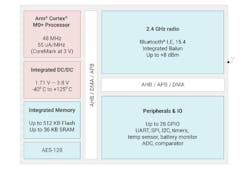Sub-$1 Wireless MCU Brings Bluetooth LE to More Devices
This article is part of our Embedded World 2022 coverage.
Texas Instruments expanded its connectivity portfolio with a new family of wireless MCUs that promises to bring Bluetooth LE (BLE) to a new generation of Internet of Things (IoT) devices at a fraction of the cost and power.
The semiconductor giant said the CC2340 family of wireless MCUs come in a compact package that sips less than 1 µA of standby power, with prices starting at less than $1. That translates to a 40% reduction in power at around 50% of the cost of similar MCUs, according to TI, making it easier than ever to add BLE to virtually any device. It is promising several other areas of improvement, including more on-chip flash memory.
The CC2340R2 (with 256 kB of flash) and CC2340R5 (with 512 kB) MCUs are the fourth generation in the SimpleLink family of wireless MCUs for industrial, automotive, and consumer markets critical to TI’s future.
With its first BLE MCUs released a decade ago, TI said the CC2340 family is a step up from its predecessors, making it more affordable to connect everything from lights, locks, thermostats, and other consumer goods to medical wearables and industrial sensors. The company consulted with its customers over the last decade to dial in the CC2340, landing on what it calls a “sweet spot” of RF performance, power, and price.
“This family is the result of more than a decade of listening to developers and our customers, optimizing the way we designed the chip from the ground up," said Marian Kost, VP and GM of connectivity at TI, in a briefing ahead of embedded world, where it introduced the CC2340.
A wireless war has erupted in the IoT landscape, with companies betting on a broad range of short-range wireless standards such as Wi-Fi, NB-IoT, Cat-M1, and others frequently overlapping each other. But BLE has become one of the most widespread wireless IoT standards: Around 35% of all IoT devices use BLE to link themselves to a smartphone or other device wirelessly, according to market research firm ABI Research.
Consequently, wireless MCUs have become a major battleground in the chip market, with the likes of Infineon, NXP, Renesas, and Silicon Labs sparring to swipe more market share. Global shipments of IoT devices with BLE are set to rise from 5.2 billion units in 2022 to more than 7 billion in 2026, according to ABI Research.
"The affordability of the device brings a lot of flexibility," Kost said in a briefing ahead of embedded world. "It allows developers to add Bluetooth LE to any application that also requires a very aggressive price point."
TI is also raising the radio-frequency output power of the CC2340 family up to +8 dBm, which the company claims is unrivaled by BLE MCUs in the same class. “This will allow customers to build more robust RF links and extend range and robustness, specifically in congested environments," said Kost. The wireless MCUs also integrate several key RF components that help simplify designs, which in turn leads to cost savings.
With the CC2340R2 and CC2340R5 offering 256 kB and 512 kB of flash memory, respectively, the new chips have additional space for the increasing amount of software in consumer, medical, and industrial devices.
The MCU family also features 36 kB of RAM that can be used by customers to update firmware and software remotely over time as necessary. Configurations with additional on-chip memory are in the pipeline.
The CC2340R5 comes in a 5- × 5-mm QFN package, while the CC2340R2 fits in a smaller footprint of 4 × 4 mm. Packed with up to 26 general-purpose IOs (GPIOs), the chips can handle the harsh temperatures often encountered by industrial sensors or electric-vehicle charging systems, with a rating of 40 to 125°C.
At the heart of the new wireless MCUs is a Cortex-M0+ clocked at 48 MHz, paired with a 2.4-GHz BLE radio in a power envelope that wastes less than 830 nA of standby current, which is 40% less than its competition.
TI said the reduction in standby current prolongs battery life so that consumer and industrial IoT devices can last for weeks—and even up to a decade in ultra-low-power wireless sensors—on a coin-cell battery.
To get started with the CC2340 wireless MCUs, customers can request samples as well as a development kit priced at $39. Customers also get access to a BLE software stack that TI has supported for over a decade.
The new family of wireless MCUs is scheduled to be in volume production by the first half of 2023. Pricing for the family will start at $0.79 in 1,000-unit quantities.
This article is part of our embedded world 2022 coverage.



